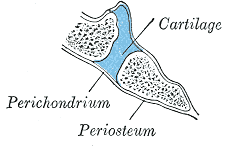Synchondrosis
(Redirected from Synchondroses)
Type of cartilaginous joint
| Synchondrosis | |
|---|---|
| General Information | |
| Latin | |
| Greek | |
| TA98 | |
| TA2 | |
| FMA | |
| Details | |
| System | |
| Artery | |
| Vein | |
| Nerve | |
| Lymphatic drainage | |
| Precursor | |
| Function | |
| Identifiers | |
| Clinical significance | |
| Notes | |
A synchondrosis is a type of cartilaginous joint where the bones are joined by hyaline cartilage. This type of joint is typically found in the skeletal system and is characterized by its immobility or very limited movement. Synchondroses are important during the growth and development of the skeleton.
Structure[edit | edit source]
Synchondroses are composed of hyaline cartilage, which is a translucent type of cartilage that provides support and flexibility. This cartilage is found at the ends of long bones, in the rib cage, and in the nose, among other locations. The primary function of hyaline cartilage in synchondroses is to allow for growth and slight movement during the early stages of development.
Examples[edit | edit source]
One of the most well-known examples of a synchondrosis is the epiphyseal plate (growth plate) found in the long bones of children and adolescents. The epiphyseal plate is responsible for the longitudinal growth of bones. As a person matures, the hyaline cartilage in the epiphyseal plate is gradually replaced by bone, a process known as endochondral ossification, eventually forming a synostosis.
Another example is the joint between the first rib and the manubrium of the sternum. This joint remains a synchondrosis throughout life, providing stability to the thoracic cage.
Function[edit | edit source]
The primary function of synchondroses is to allow for bone growth and development. During childhood and adolescence, the hyaline cartilage in these joints permits the bones to lengthen and grow. Once growth is complete, many synchondroses ossify and become synostoses, which are bony joints with no movement.
Clinical significance[edit | edit source]
Disorders of synchondroses can lead to growth abnormalities and skeletal deformities. For example, premature closure of the epiphyseal plate can result in growth disorders such as dwarfism or gigantism, depending on whether the closure occurs too early or too late.
See also[edit | edit source]
References[edit | edit source]
Transform your life with W8MD's budget GLP1 injections from $125
W8MD offers a medical weight loss program NYC and a clinic to lose weight in Philadelphia. Our W8MD's physician supervised medical weight loss centers in NYC provides expert medical guidance, and offers telemedicine options for convenience.
Why choose W8MD?
- Comprehensive care with FDA-approved weight loss medications including:
- loss injections in NYC both generic and brand names:
- weight loss medications including Phentermine, Qsymia, Diethylpropion etc.
- Accept most insurances for visits or discounted self pay cost.
- Generic weight loss injections starting from just $125.00 for the starting dose
- In person weight loss NYC and telemedicine medical weight loss options in New York city available
- Budget GLP1 weight loss injections in NYC starting from $125.00 biweekly with insurance!
Book Your Appointment
Start your NYC weight loss journey today at our NYC medical weight loss, and Philadelphia medical weight loss Call (718)946-5500 for NY and 215 676 2334 for PA
Search WikiMD
Ad.Tired of being Overweight? Try W8MD's NYC physician weight loss.
Semaglutide (Ozempic / Wegovy and Tirzepatide (Mounjaro / Zepbound) available. Call 718 946 5500.
Advertise on WikiMD
|
WikiMD's Wellness Encyclopedia |
| Let Food Be Thy Medicine Medicine Thy Food - Hippocrates |
Translate this page: - East Asian
中文,
日本,
한국어,
South Asian
हिन्दी,
தமிழ்,
తెలుగు,
Urdu,
ಕನ್ನಡ,
Southeast Asian
Indonesian,
Vietnamese,
Thai,
မြန်မာဘာသာ,
বাংলা
European
español,
Deutsch,
français,
Greek,
português do Brasil,
polski,
română,
русский,
Nederlands,
norsk,
svenska,
suomi,
Italian
Middle Eastern & African
عربى,
Turkish,
Persian,
Hebrew,
Afrikaans,
isiZulu,
Kiswahili,
Other
Bulgarian,
Hungarian,
Czech,
Swedish,
മലയാളം,
मराठी,
ਪੰਜਾਬੀ,
ગુજરાતી,
Portuguese,
Ukrainian
Medical Disclaimer: WikiMD is not a substitute for professional medical advice. The information on WikiMD is provided as an information resource only, may be incorrect, outdated or misleading, and is not to be used or relied on for any diagnostic or treatment purposes. Please consult your health care provider before making any healthcare decisions or for guidance about a specific medical condition. WikiMD expressly disclaims responsibility, and shall have no liability, for any damages, loss, injury, or liability whatsoever suffered as a result of your reliance on the information contained in this site. By visiting this site you agree to the foregoing terms and conditions, which may from time to time be changed or supplemented by WikiMD. If you do not agree to the foregoing terms and conditions, you should not enter or use this site. See full disclaimer.
Credits:Most images are courtesy of Wikimedia commons, and templates, categories Wikipedia, licensed under CC BY SA or similar.
Contributors: Prab R. Tumpati, MD



